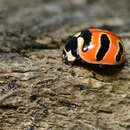Conservation Status
provided by University of Alberta Museums
Decrease in relative abundance due to competitive displacement by C. septempunctata. No evaluation, but may be a candidate for future conservation efforts.
- license
- cc-by-nc
- copyright
- University of Alberta Museums
Cyclicity
provided by University of Alberta Museums
No studies on lifespan exist, but like most Coccinellidae species, it has two generations in one year. It emerges during early spring. The second generation adults probably emerge sometime during summer. There may be some overlap between the two generations, but only the second generation will over winter (ADW, 2012).
- license
- cc-by-nc
- copyright
- University of Alberta Museums
Distribution
provided by University of Alberta Museums
Extends throughout most of North America, except northern Canada, northern Alaska and Pacific coast. C. t. subversa on the other hand is found in Pacific Northwest (Belicek, 1976; Kits, 2005).
- license
- cc-by-nc
- copyright
- University of Alberta Museums
General Description
provided by University of Alberta Museums
The subspecies C. t. perplexa (Mulsant) is commonly found in Alberta. It is 4.0-5.0 mm long. It is a round ladybug with reddish-orange elytra with three black bands. Middle and apical bands are interrupted and appear discontinuous (Acorn, 2007; Belicek, 1976). The subspecies C. t. subversa (LeConte) is found in Pacific states. The elytron of this close relative is usually not pigmented and only has the 1st of the three black bands (Johnson, 1910).
- license
- cc-by-nc
- copyright
- University of Alberta Museums
Habitat
provided by University of Alberta Museums
Alfalfa fields, peach and apple orchids, parklands and boreal forest were the preferred habitats before the arrival of C. septempunctata. Now more of a habitat specialist (Belicek, 1976; Hodek & Honek, 1996).
- license
- cc-by-nc
- copyright
- University of Alberta Museums
Life Cycle
provided by University of Alberta Museums
Not much is known about the life history of this species, but much can be extrapolated from its close relative Coccinella transversoguttata. Adult females will lay eggs when the average temperature is around 120C. The larvae have four instars before it pupates. The adult will emerge during summer. Not much is known about reproduction, but adults can mate multiple times with different partners (ADW, 2012).
- license
- cc-by-nc
- copyright
- University of Alberta Museums
Trophic Strategy
provided by University of Alberta Museums
In a laboratory test, it did not seem to be picky (Belicek, 1976). Although it can feed on pollen, it needs more to finish its developmental stages. In an experiment the larvae ate various nymph leafhopper species (Belicek, 1976; Hodek & Honek, 1996).
- license
- cc-by-nc
- copyright
- University of Alberta Museums
Coccinella trifasciata
provided by wikipedia EN
Coccinella trifasciata, the three-banded lady beetle, is a species of lady beetle in the family Coccinellidae.[1][2] It has a broad distribution, including North America, Europe, Northern Asia (excluding China), Oceania, and Southern Asia.[1][3]
Subspecies
These three subspecies belong to the species Coccinella trifasciata:
-
Coccinella trifasciata perplexa Mulsant, 1850
-
Coccinella trifasciata subversa LeConte, 1854
-
Coccinella trifasciata trifasciata Linnaeus, 1758
References
- license
- cc-by-sa-3.0
- copyright
- Wikipedia authors and editors
Coccinella trifasciata: Brief Summary
provided by wikipedia EN
Coccinella trifasciata, the three-banded lady beetle, is a species of lady beetle in the family Coccinellidae. It has a broad distribution, including North America, Europe, Northern Asia (excluding China), Oceania, and Southern Asia.
- license
- cc-by-sa-3.0
- copyright
- Wikipedia authors and editors

